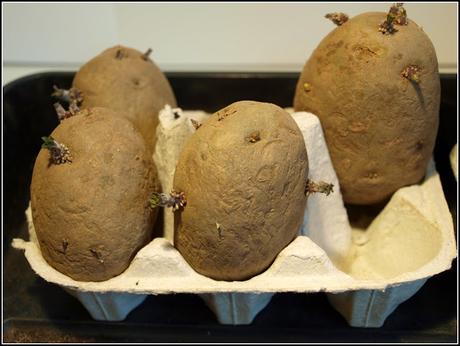
Potatoes "chitting" - See below...
Potato types
Most types of potato fall into one of three main categories related to their harvesting times. No prizes for guessing that a “First Early” type is normally harvested before a “Second Early” type! The term “Maincrop” also gives us a clue that this type is the one with the biggest expected yields.
First Early potatoes are the classic “New Potato” types. They are the first to be planted and mature very quickly (typically 10 weeks). Gardeners often vie with one another to produce them as early as possible in the year. This type is often harvested when the tubers are very small, at which stage their flesh will be light and insubstantial and their skins so thin that they can be rubbed off with the fingers. The expected yields are small – maybe 500g per seed-tuber. Examples include "Sharpe's Express", "Rocket" and "Belle de Fontenay".
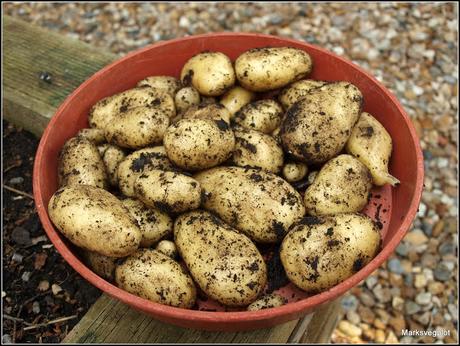
"Lady Christl" - 1st Early
Second Early potatoes are often (though not necessarily) planted at the same time as the First Earlies, but take longer to mature (typically 13 – 14 weeks). The tubers they produce are usually a bit bigger and firmer than the First Early types, but still tender. A typical yield would be 700 – 800g per seed-tuber. Examples include "Charlotte", "Kestrel" and "Nadine".
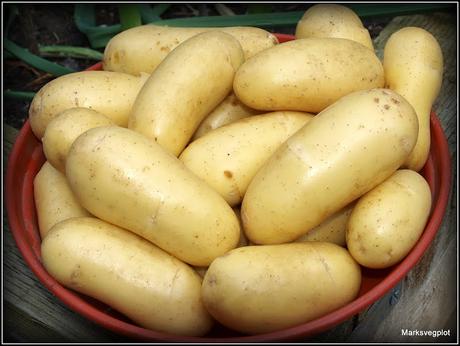
"Charlotte" - 2nd Early
Maincrops (sometimes sub-divided into “Early Maincrop” and “Late Maincrop” types) are usually planted later than the early varieties and take longer to grow (typically 20 weeks or more), which means they are harvested in late Summer or early Autumn. Their big advantages are that they produce much heavier and bulkier yields, and the tubers will normally remain in good condition for many months if stored properly. The flesh of Maincrop potatoes is often a lot more substantial and more filling than the other types. Grown in a container, a typical yield would be approx. 1.5 – 2kgs per seed-tuber. Examples include "King Edward", "Desiree" and "Sarpo Mira".
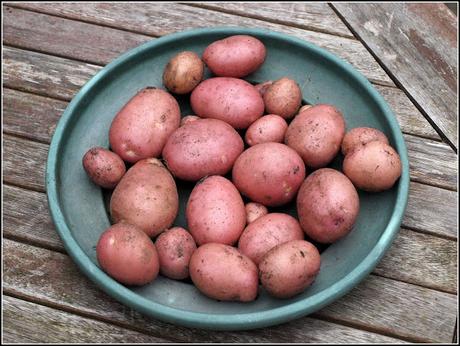
"Maxine" - Early Maincrop
Flesh types
The flesh type of potatoes can differ markedly from variety to variety – some are “waxy” (with close-textured, smooth flesh), and some are “floury” (with flesh that goes soft, crumbles or breaks up when cooked).
When choosing which varieties to grow you should think about how you like potatoes cooked: floury potatoes are good for mashing and for baking to make beautiful fluffy Jacket Potatoes, but they often disintegrate when boiled. A firmer, waxier, variety is best for boiling or for making chips / French fries. When buying your seed potatoes always enquire about this – a reputable supplier should be able to tell you what you need to know.
Once you get past the novice stage, you will probably also want to think about the size, shape and color of the potatoes you grow. Will they be large, medium or small? Will they be round, or oval or long? Will they be white, yellow, creamy – or even red, black or multi-coloured? Coloured potatoes are quite trendy, but personally I’m not a great fan of them. I find that the color usually fades on cooking and ends up a dirty, unappetising grey! (There are exceptions of course, such as “Blue Danube”, which retains its color well).
Planting times
The decision on when to plant potatoes depends a lot on your local weather. Potato foliage is very susceptible to frost damage, and because of this it is inadvisable to plant too early unless you can provide some suitable protection. My suburban garden in Fleet, Hampshire, is about 30 miles south of London, and the climate here is relatively mild, but even so our last frost of the year is usually in mid-May.
Each year I plant my potatoes in late March or early April, but with protection as described below. In a city, the temperatures are often higher than out in the suburbs or countryside and you will therefore be able to plant earlier. I’m lucky enough to have some small plastic greenhouses which are each just the right size to accommodate four of the pots in which I grow my potatoes.
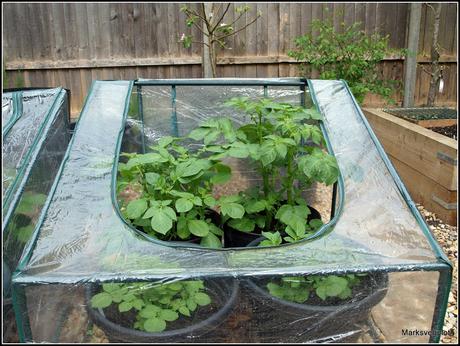
If you don’t have anything like that, another option is to cover your plants with a couple of layers of horticultural fleece when frost is forecast. In an emergency you can also achieve (for a short space of time) much the same effect with some pages of newspaper, weighed-down with bricks or something similar.
Storage considerations
Neither the First Earlies or Second Earlies keep very well, and are seldom stored for later use. They are too delicious anyway – definitely best eaten within days (preferably hours) of harvest. Maincrops, on the other hand, will keep for months if properly stored. If you plan to store potatoes for a long time, here are a few tips:
- Dry the potatoes in the open air (preferably in sunshine) for a few hours, until you are able to rub off most of the soil / compost. Drying also fixes (hardens) the skin which helps with avoiding moisture loss.
- Remove any damaged tubers – eat them or discard them, because they will soon rot
- Put the good tubers into breathable containers, such as paper or hessian/burlap sacks. Plastic will cause the tubers to sweat and therefore potentially to rot
- Store the potatoes in lightproof containers, preferably in a dark place. If light reaches them they will turn green and become toxic
- Store the sacks / containers in a cool but frost-free location, such as a garage or well-insulated shed. If they get too warm, the potatoes will quickly begin to sprout
- Check the stored tubers frequently (maybe once a month?) to see that they are OK.
- Discard any that show signs of rotting.
- Do what you can to protect your potatoes from rodent damage
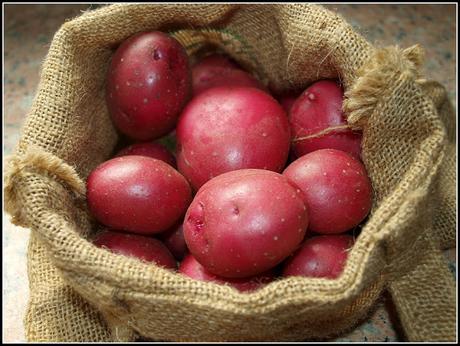
Potatoes being stored in a hessian bag
Other potato-related terminology
- Haulm - an old-fashioned English word meaning the foliage of the potato plant.
- Chit - a young shoot or sprout on a seed potato, from which the leaves will in due course grow. Sometimes used as a verb – “To chit” means to allow the seed tubers to produce shoots.
- Tuber - the part of the plant that you eat. The part that people call “the potato”. It grows underground, on the roots of the plant.
- Seed tuber - a tuber that has been saved after harvesting, and which when planted will produce another plant – so the equivalent of a seed.
- Earthing-up also Hilling (USA) - progressively covering with soil the emerging shoots of a potato plant as it grows, causing the underground tuber-bearing part of the plant to be taller. Also prevents light reaching the developing tubers and making them turn green (and therefore poisonous).
- Salad potato - normally a First or Second Early type, often with waxy flesh, grown for using cooked and cooled, in a salad.
- Blight - normally refers to Late Blight - a disease of solanaceous plants (such as the potato and tomato) that is caused by a fungus (Phytophthora infestans) and is characterized by decay of stems, leaves, and in the potato also of tubers. The most common and most deadly disease affecting potatoes. There is no known cure, and once the disease strikes it is best to cut off and burn the plant’s foliage. The underground tubers will probably be OK if you act promptly! Some potato varieties have a certain resistance to Blight, especially those developed by the Sarvari trust, whose potatoes are mostly given names including the word “Sarpo” – e.g. “Sarpo Mira”, “Sarpo Axona” etc.
- Scab – a common disease of potatoes, leaving the tubers covered in unsightly but harmless brown lesions or scabs. The incidence of Scab can be decreased by including plentiful organic matter in the growing-medium.
